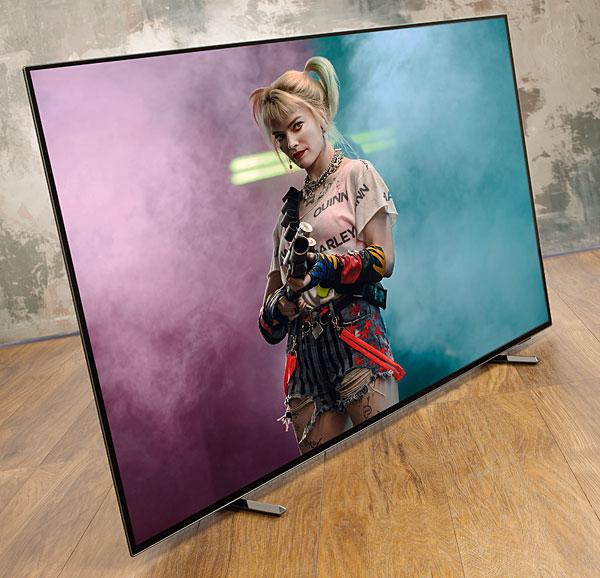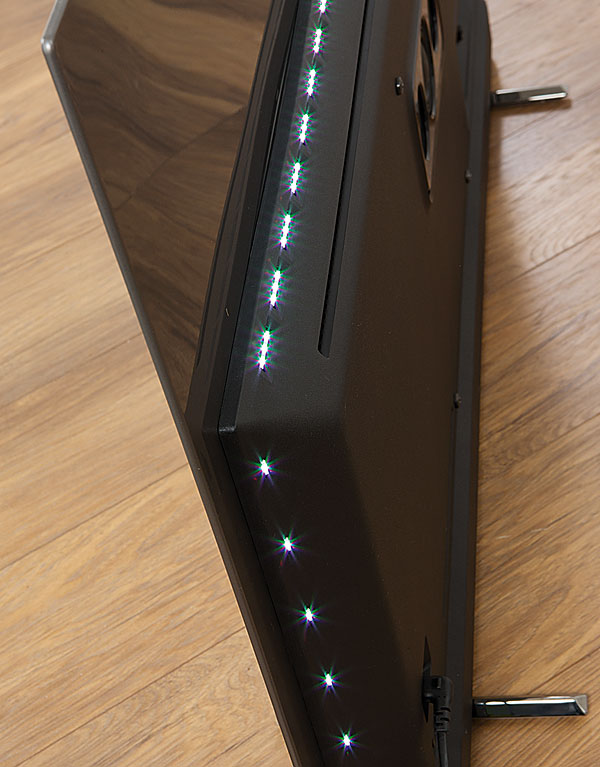Philips 55OLED805 4K OLED TV review

 The 805 is the smartest Philips OLED flatscreen yet, says an awestruck Steve May
The 805 is the smartest Philips OLED flatscreen yet, says an awestruck Steve May
Philips' new OLED805 may look at first glance like a numerical refresh of last year's 804 model, but there's far more to it than that. This multi-HDR compatible set bristles with advanced new picture technology, and is arguably the most significant Philips launch since the debut of its P5 image processing suite.
It's available in 65in and 55in screen sizes, and we went for the latter for this review. At £1,500, this smaller model has a price that will tempt shoppers seeking to refresh their setup.
The TV's cosmetic design is also appealing. Like its predecessor, the OLED805 looks sleek and contemporary, without going full Scandi. The frame now comes in gun- metal grey, and the two edge-placed feet are chamfered and finished in dark chrome. The screen itself sits virtually flush, although risers to lift it up in order to accommodate a soundbar are provided.
It's also mostly wafer-thin, only bulging out at the midway point to accommodate electronics and inputs. Connections are four 4K HDR-capable HDMI inputs; two USB ports; a digital optical audio output; an AV minijack for legacy hardware; headphone out;, and Ethernet to bolster dual-band Wi-Fi and Bluetooth.
Disappointingly none of this set's HDMIs support 4K at 120fps, and when we reached out to Philips for clarification, there was no reassurance that a firmware update would resolve the situation. 4K at 120fps is, of course, part of the attraction of the upcoming PlayStation 5 and Xbox Series X games consoles, and it's worth knowing that this set isn't ready for it. But as we're to discover, gaming really isn't central to the OLED805 proposition, so maybe we shouldn't be too surprised. And if it's any consolation, we're told 4K/120 is on the roadmap for next year. So that'll be the OLED806 then...
Light Entertainment
The TV features a three-sided implementation of Philips' Ambilight mood/bias lighting system. Functionality follows what we've seen before, but there are some changes. Joining Sunrise mode – first introduced last season to wake the TV at a designated alarm time and run through a faux sunrise routine with lighting effects and music – is Ambisleep, which will send you off with a warm glow accompanied by some soothing sounds. The Ambilight Follow Colour mode, which throws a flat hue against any surrounding wall, has been renamed Lounge Light, which is rather more descriptive.

The set will also work with new Philips Ambilight-equipped wireless speakers (designated W6205 and W6505 specifically). So-called Ambilight Air – coming via a firmware update – works by syncing the TV's lighting system to these new stereo speakers, which also have mini Ambilight lamps built-in. This lighting extension doesn't require a separate Hue Lighting hub.
Potentially more significant, the OLED805 is compatible with DTS Play-Fi, a streaming alternative to Sonos and HEOS that allows the TV to interoperate with other Play-Fi components, including Philips' own soundbars and a host of third-party speakers. DTS Play-Fi supports high-res audio and multiroom playback. If you've not yet got into whole-house audio, it could be well worth investigating.
The smart platform du jour remains Android, here in v.9 guise. The most stable implementation yet of Google's telly OS, it offers heavyweight streaming apps (Netflix, Prime Video, Disney+ and YouTube to name just a few) and is compatible with both Google Assistant and Amazon Alexa. The amount of RAM onboard has been increased, so fill your boots from Google Play...
The OLED805 comes with a Freeview Play tuner, which means there's a full complement of mainstream catch-up TV players onboard. And it also has Chromecast built-in for easy streaming.
AI, AI, It's Off To Work We Go
Image quality from this new season OLED is terrific, and there's multiple reasons why. Most obviously, Philips' fourth-generation P5 picture engine now employs AI processing, which enjoys a spectacular debut.
AI makes native 4K HDR preternaturally sharp, and adds extra edge to HD SDR. The result is an often stunningly realistic image, with detail and colour depth that seems out-of-this-world. Skin tones and hair exhibit touch-me texture. The impact of AI even extends to the Android UI, which almost seems to glow.
The processing at play here is quite brilliant – for the most part it totally wowed – but occasionally I felt it maybe pushed the picture processing envelope a little too far.
It was sometimes like watching a Vivid mode TV on steroids and it appeared to struggle when interpreting film grain. So ultimately, I dipped in and out, particularly when it came to watching movies.
 |
Home Cinema Choice #351 is on sale now, featuring: Samsung S95D flagship OLED TV; Ascendo loudspeakers; Pioneer VSA-LX805 AV receiver; UST projector roundup; 2024’s summer movies; Conan 4K; and more
|

















































